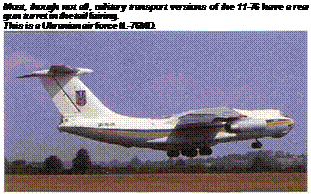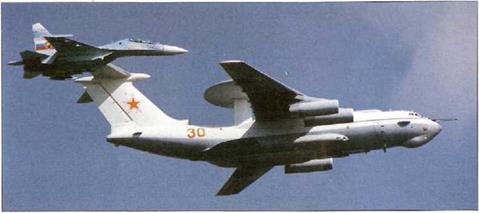Ilyushin 11-76, 11-78, Beriev A-50 Transport and AEW platform
|
|
T |
he Ilyushin 11-76 (NATO code-name ‘Candid’) was developec as a successor to the An-12 for both Aeroflot and the Soviet air force. Larger, heavier and more powerful than the contemporary Lockheed C-141. the 11-76 uses extensive high lift devices, thrust reverses and a high flotation undercarriage to achieve much better short – and rough – field performance. The cargo hold is fully pressurised and can be quickly reconfigured by using interchangeable passenger, freight or air ambulance modules. The first prototype ‘Candid-A’ made its first flight on 25 March 1971 and a development squadron was in service by 1974. Series production began in 1975 and more than 850 had been built by the beginning of 1999, with production continuing ‘for stock’ at a trickle.
‘Candid-A’ (civil) and ‘Candid-B1 (military) subtypes comprise the basic military 11-76, the civil II-76T and military II-76M with additional fuel tankage, and the similar II-76TD and military II-76MD with uprated Soloviev D-30KP-1 turbofens for improved ‘hot-and-high’ performance. Other military ‘Candid-As’ include the 11-76 Skalpel and 11-76 Aibolit mobile operating theatres, the II-76PP ECM jammer (four produced, but never deployed), the II-76VKP (11-82) communications relay aircraft, and
the new sireiched II-76MF, with more powerful PS-90AN turbofans. This was flown in August 1995, and eight are in production. There have also been four II-76LL engine testbeds, II-76K, II-76MDK and II-76MDK-2 cosmonaut training aircraft and a single II-76MDP firebomber conversion. Foreign operators include India, Iran, Iraq, Libya, North Korea, Syria and Yemen.
The II-78M ‘Midas’ is a three-point tanker fitted with three UPAZ external refuelling HDUs, one under each wing and one mounted on the port side of the rear fuselage. Internally the II-78M has two pallet-mounted tanks in the hold; each contains 35 tonnes of fuel.
The A-50 ‘Mainstay’ was developed by Beriev as an AEW and AWACS platform. It has a rotodome above the fuselage, with the nose glazing and tail turret removed and replaced by further radomes. The А-50’s performance is broadly comparable to Boeing’s E-3 Sentry, with an inferior absolute detection range, but a (claimed) superior ability to discriminate against ground clutter. The improved A-50M has the more advanced Shmel-2 radar. Related variants are the II-976 (11-76 SKIP) range control aircraft and Iraq’s indigenously developed Adnan and Baghdad AEW conversions.
 Specification: Ilyushin II-76M ’Candid-B Powerplant: four; 17.68-kN (26,455 lb) PNP° ’Aviadvigataf (Soloviev) D-30KP turbofans Dimensions: wing span 50.50 m (165 It 5 in); length 4S 59 m (152 ft 10k in); height 14.76 m I48 ft 5 in)
Specification: Ilyushin II-76M ’Candid-B Powerplant: four; 17.68-kN (26,455 lb) PNP° ’Aviadvigataf (Soloviev) D-30KP turbofans Dimensions: wing span 50.50 m (165 It 5 in); length 4S 59 m (152 ft 10k in); height 14.76 m I48 ft 5 in)
Weights: max lake-cff 170000 kg (374,780 lb); maximum payload 4CC00 kg (88,183 lb) Performance: max mum level speed 850 kmh (528 mph|; cruising speed between 750 and 800 kmh (465 and 497 mplt): absolute ceiling about 15500 m (50,855 ft); ferry range G700 km (4,163 miles); range 50G0 km (3,107 miles) with maximum payload
Armament: rear turret with gunner and twin radar-directed NR-23 23-mm cannon












